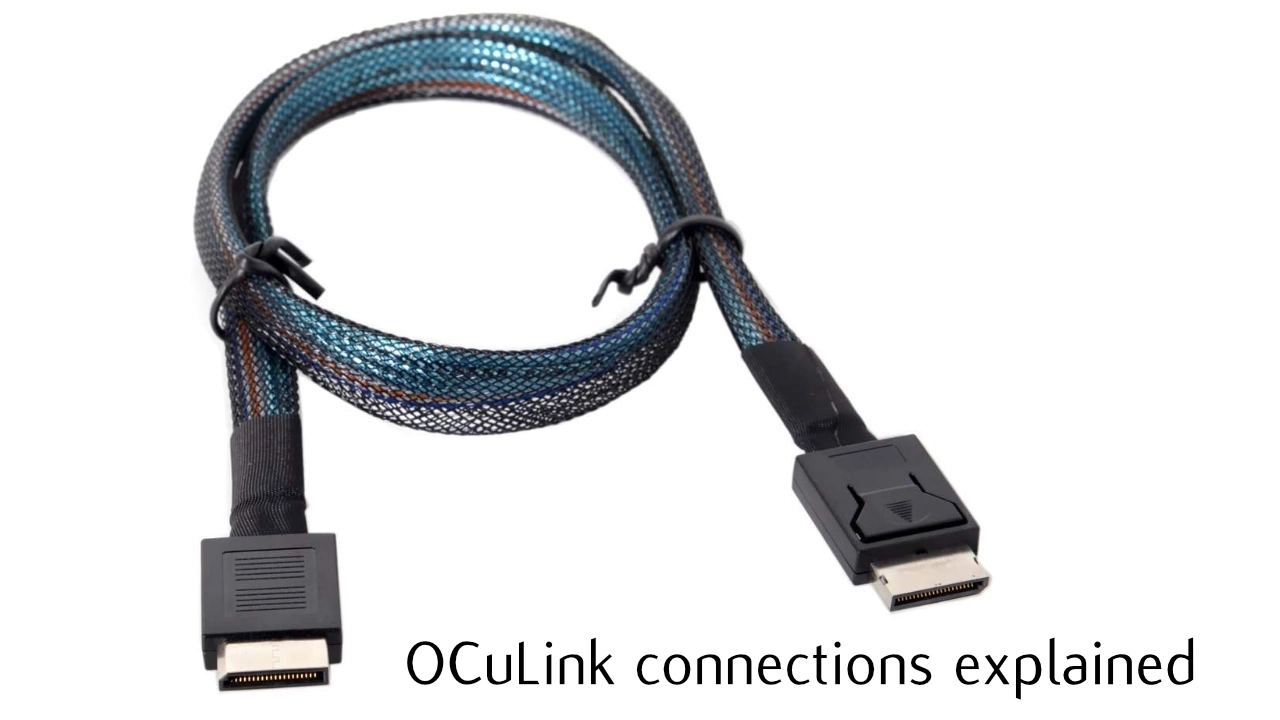In an era where high-speed data transfer and efficient connectivity are paramount, OCuLink emerges as a fantastic technology for connectivity. Its growing presence in both server and consumer devices marks a significant shift in how we approach external data transfer and peripheral connectivity. This guide will provide more information on its benefits, costs applications and its availability.
OCuLink what is it?
OCuLink, standing for Optical-Copper Link, is a connection standard designed for externalizing PCIe (Peripheral Component Interconnect Express) devices. Initially confined to server rooms and specialized setups, OCuLink has gradually infiltrated the consumer technology market. Originating nearly a decade ago, it has evolved to address the rising demands for high-speed, external data and graphic card connectivity.
OCuLink’s claim to fame lies in its impressive technical prowess. It boasts a maximum bandwidth capability of up to 16 GB/s and is compatible with various versions of PCIe devices, offering flexibility and scalability in its usage. Additionally, its design facilitates direct extension from a device’s PCIe slot, making it an efficient option for external connections.
OCuLink vs. Thunderbolt
The technological landscape often presents various options for similar needs, each with its unique strengths and weaknesses. This is particularly true when comparing OCuLink and Thunderbolt, two standards that fundamentally address the same problem — high-speed data transfer and peripheral connectivity — but in different ways.
OCuLink:
- Bandwidth: Up to 16 GB/s, dedicated solely to data transfer.
- Cost: More affordable due to the absence of licensing fees for manufacturers.
- Standard: Open standard, allowing any manufacturer to implement it without additional costs.
- Target Usage: Ideal for scenarios requiring high-speed data transfer, like external GPU setups.
- Market Position: Less common than Thunderbolt, but growing in adoption, especially in high-performance and cost-conscious markets.
Thunderbolt:
- Bandwidth: Up to 40 Gbps (Thunderbolt 3 and 4), but shared with other functions like video output and charging.
- Cost: Generally higher due to licensing fees and proprietary technology.
- Standard: Proprietary, developed by Intel in collaboration with Apple.
- Target Usage: Favored for its versatility, supporting data transfer, charging, and video output in one connector.
- Market Position: Widely adopted in a variety of devices, known for reliability and ease of use.
Thunderbolt, developed by Intel in collaboration with Apple, has been a market favorite for years. Known for its user-friendly, plug-and-play nature, Thunderbolt has become synonymous with reliability and ease of use. It integrates data transfer, charging, and video output in a single connector, offering a streamlined and efficient user experience. This universality has led to its widespread adoption in a variety of devices, from high-end laptops to professional-grade peripherals.
However, Thunderbolt’s strengths come with certain limitations and costs. Licensing fees associated with its use can drive up the prices of Thunderbolt-equipped devices and accessories. Moreover, while Thunderbolt 3 and 4 offer substantial bandwidth (up to 40 Gbps), they are often not fully utilized due to their shared nature with other functions like video and charging.
What are differences between OCuLink and Thunderbolt?
Other articles we have written that you may find of interest on the subject of OCuLink :
OCuLink: The Performance-Centric Alternative
OCuLink, on the other hand, emerges as a more specialized solution focused on maximizing performance, particularly in the realm of external PCIe connections. It offers a direct extension of a device’s PCIe slot, ensuring a high bandwidth capacity of up to 16 GB/s dedicated solely to data transfer. This specialization makes OCuLink an ideal choice for scenarios where data transfer speed is paramount, such as in external GPU setups and high-end data processing tasks.
The open standard nature of OCuLink is one of its most significant advantages over Thunderbolt. Being an open standard means that any manufacturer can implement OCuLink without the need for licensing fees. This absence of additional costs makes OCuLink components — such as adapters, docks, and cables — more affordable compared to their Thunderbolt counterparts. For consumers, this translates to a lower overall investment for a high-performance setup.
Cost-Effectiveness and Accessibility
The cost-effectiveness of OCuLink extends beyond just the initial purchase price. Its open nature fosters a competitive market for OCuLink-compatible devices and accessories, potentially driving prices down further and spurring innovation. Additionally, the lower cost barrier makes high-speed, efficient data transfer more accessible to a broader audience, including small-scale creators, independent professionals, and tech enthusiasts on a budget.
Performance in Real-World Applications
In practical terms, OCuLink’s superior bandwidth and dedicated data transfer capabilities provide tangible benefits. For example, in external GPU (eGPU) setups, OCuLink can deliver higher frame rates and lower latency, directly impacting the quality of graphics rendering and the overall user experience. This is particularly important for applications requiring intense graphical processing, such as 3D rendering, video editing, and gaming.
While Thunderbolt continues to hold its ground as a versatile and user-friendly option, OCuLink stands out for its performance-centric approach and cost-effectiveness. Its growing adoption in consumer devices and potential in specialized applications positions OCuLink as a compelling alternative for users prioritizing high-speed data transfer and affordability. As the tech landscape evolves, the choice between Thunderbolt and OCuLink will increasingly depend on the specific needs and priorities of the users, with OCuLink carving out its niche in high-performance scenarios.
Connecting external graphics cards using OCuLink
Advantages of OCuLink :
OCuLink’s benefits extend across various user groups, particularly appealing to gamers and content creators.
- High Bandwidth: For gamers, the higher bandwidth means more fluid graphics, better frame rates, and lower latency in external GPU (eGPU) setups.
- Cost-Effectiveness: The affordability of OCuLink components makes it a budget-friendly option, a crucial factor for hobbyists and professionals alike.
- Versatility and Future-Proofing: OCuLink’s compatibility with different PCIe versions ensures it can keep up with evolving technology, making it a future-proof investment.
Real-World Applications: Bringing OCuLink to the Forefront
The adoption of OCuLink in devices like the GPD G1 marks a significant milestone. This device not only supports Thunderbolt 4 but also integrates OCuLink, providing users with the best of both worlds. It comes equipped with a built-in power supply and supports high-end graphics cards, demonstrating OCuLink’s potential in practical, consumer-friendly applications.
OCuLink in the Gaming and Content Creation Sphere
In gaming and content creation, performance is paramount. OCuLink shines in these areas by offering enhanced bandwidth capabilities, allowing for more effective use of external graphics solutions. This translates into tangible benefits such as improved rendering times and smoother gameplay, vital for professionals and enthusiasts who demand peak performance.
Cost comparisons
Both performance and cost-efficiency are highly prized, OCuLink stands out for its unique economic advantages. The cost benefits of this technology are a significant factor in its growing appeal and adoption. One of the fundamental ways OCuLink maintains its cost advantage is through the absence of licensing fees.
Unlike proprietary technologies like Thunderbolt, which require manufacturers to pay for usage rights, OCuLink is an open standard. This openness means that any manufacturer can implement OCuLink without incurring additional costs associated with licensing. The implications of this are two-fold:
- Lower Manufacturing Costs: For device manufacturers, the absence of licensing fees translates directly into lower production costs. This is especially beneficial for smaller companies or those aiming to offer high-performance products at a competitive price point.
- Reduced Retail Prices: Lower manufacturing costs often lead to lower retail prices for consumers. With OCuLink, this means more affordable cables, adapters, and devices, making high-speed external PCIe connectivity accessible to a wider range of users.
OCuLink connect external GPU to Valves Steam Deck
A Competitive Marketplace
The open standard nature of OCuLink not only reduces costs but also fosters a competitive marketplace. Competition among manufacturers typically leads to more innovation, better quality products, and lower prices over time. Consumers benefit from a wider selection of OCuLink-compatible products, enabling them to choose the best option that fits their budget and performance needs.
Cost-Effectiveness in Various Scenarios
The affordability of OCuLink is particularly beneficial in scenarios where high bandwidth and data transfer speeds are crucial. For example, in external graphics card setups, the lower cost of OCuLink components makes it an attractive option for gamers, graphic designers, and video editors who require top-tier performance without a hefty investment.
Similarly, in professional settings where multiple high-speed connections are necessary, the cost savings from using OCuLink can be substantial. Small businesses and startups, often operating under tight budgets, can leverage OCuLink to build efficient, high-performance computing setups without the financial strain associated with more expensive alternatives.
Long-Term Savings
Adopting OCuLink also has long-term financial benefits. As technology evolves, the need for faster and more efficient data transfer will only increase. Investing in an OCuLink-based setup means future-proofing connectivity needs to some extent, potentially saving money on upgrades and replacements in the long run.
Why Choose OCuLink?
Looking ahead, the potential of OCuLink in the tech market is substantial. As consumer electronics continue to evolve, the demand for efficient, high-speed connectivity solutions will only increase. OCuLink, with its superior performance and cost-efficiency, is well-positioned to meet these future demands.
Choosing OCuLink comes down to a few key factors:
- Superior Bandwidth: Offering significantly higher bandwidth than its competitors, OCuLink is ideal for high-performance tasks.
- Cost-Efficiency: Its affordability makes it accessible to a broader range of users.
- Growing Adoption: With its integration into newer devices, OCuLink is becoming more mainstream, ensuring broader compatibility and support.
Conclusion: The Rising Star of Connectivity
OCuLink represents a notable shift in the realm of peripheral connectivity. Its blend of high performance, cost-effectiveness, and growing adoption makes it an increasingly attractive option for a wide array of users. As the technology landscape continues to evolve, OCuLink’s role is poised to expand, making it a key player in future computing and connectivity solutions.
Filed Under: Guides, Top News
Latest aboutworldnews Deals
Disclosure: Some of our articles include affiliate links. If you buy something through one of these links, aboutworldnews may earn an affiliate commission. Learn about our Disclosure Policy.







